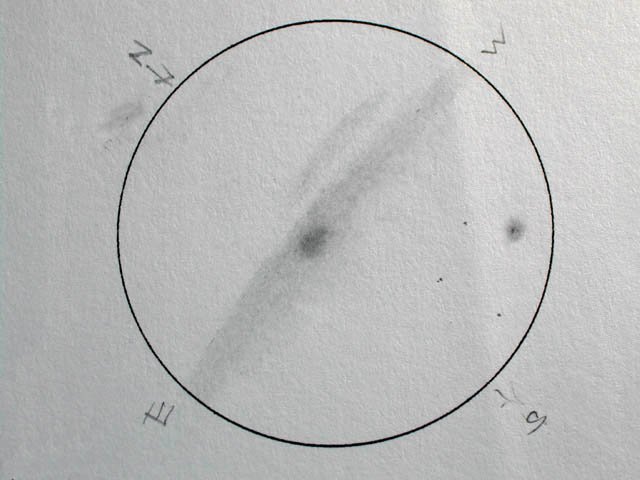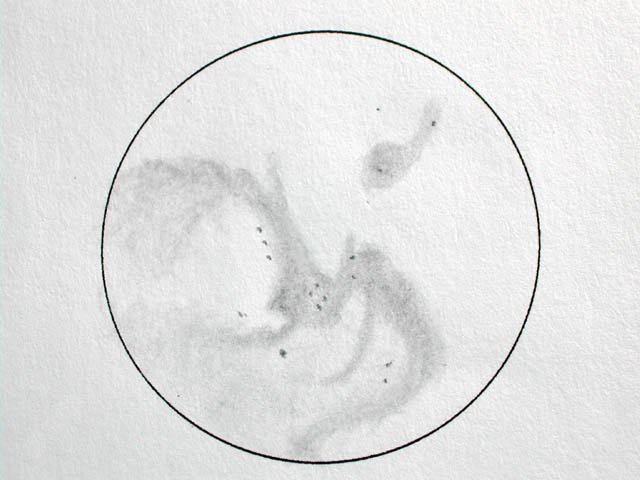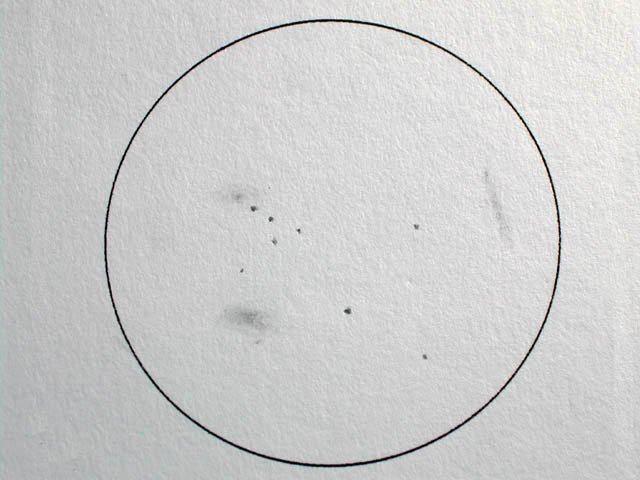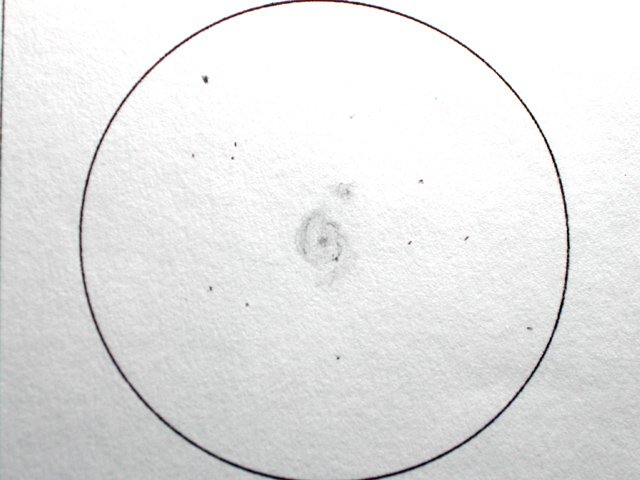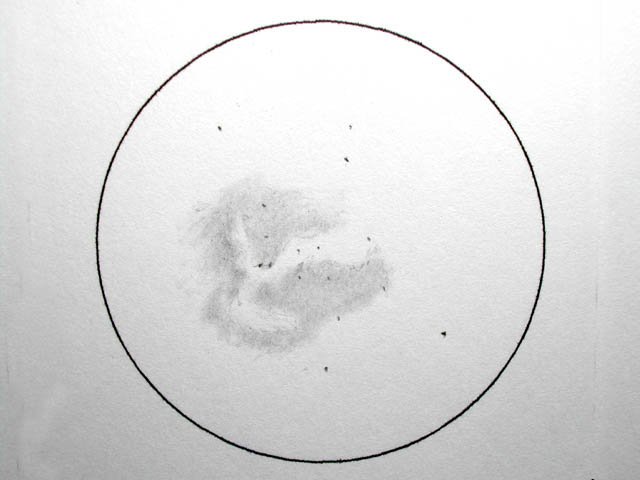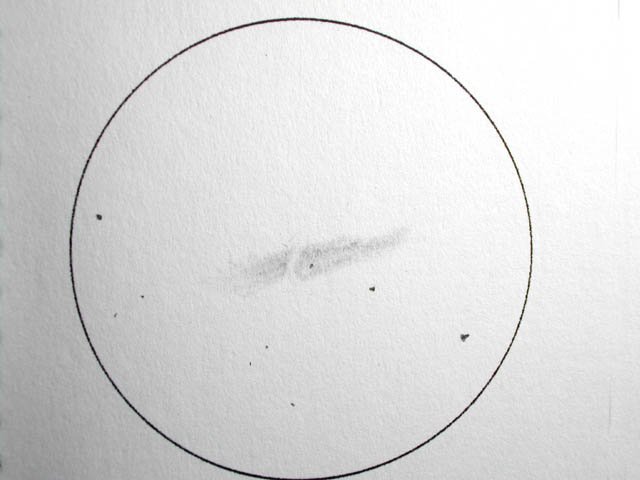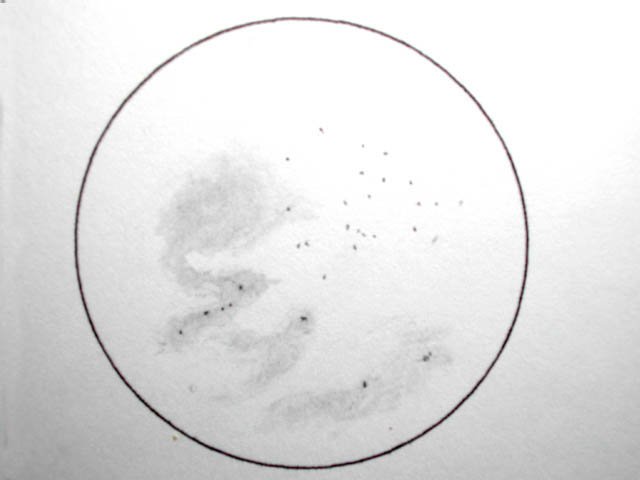ALP STARGAZING SESSION AT CALIRAYA , LAGUNA |
||||||||||
March 25, 2006 Article and Sketches by Allen Yu Image by James Kevin Ty |
||||||||||
In the company of Mr. James Kevin Ty, Mr. Tommy Tan, Dr. Jose Aguilar, Mr. Raymond Sarmiento, Mr. Brian Davis, Mr. Rafael Lunar, Mr. Jonathan Alcartado, Mr. Dante Noche, Mr. Joseph Torres, and Mr. Irving Raymundo. Limiting naked eye magnitude: Magnitude 5 or better. A bit of wind, very humid at 100% RH most of the time, dew heater a necessity. Transparency is good at times when the sky is completely void of clouds. Haze comes in thick or thin, it simply blots out the stars. If it is thick enough, it must be clouds. Clouds are invisible here because of the absence of light pollution, it simply makes the stars disappear. Telescope used: Meade 6 inch (150mm aperture) Newtonian on a Dobsonian Mount, f/8 focal ratio. Eyepiece used is set at standard 30mm, I did not change any eyepiece since the priority of the project is to log on as many Messier Objects as possible, if not all. Apparent field of view of the Plossl eyepiece is 50 degrees, so true field of view is 1.25 degrees, and magnification is 40 times. No nebular filters are used. Dew has not been a problem on the main optics, but it wreak havoc on the fluidity of the observations. Dew hit hard on the eyepiece itself, on the 9X50 Right angle finder, and my Red Dot finder. My procedure is simple. I followed on the suggested sequence of My forte is starhopping. I am in a bit of trouble if there are no bright stars to serve as guide posts. In the absence of bright stars or finally as I realized as the easier way, is to rely on the Red Dot finder to approximate an aim to the area in the sky where my target should be, then I looked through the Right angle finder of 9X50 to check some surrounding stars as also shown in the star map, and sometimes the target object readily reveal itself on the finder. I have to note that this finder is quite a pity to give enough brilliance to the object. I find ordinary pair of binoculars more suitable to "detect" objects since most deep sky objects appear considerably brighter in the binoculars than on the 9X50 finder. The reason I supposed is the Amici Prism, that is, too much areas bouncing off the many angles inside the prism presents too much light loss. Okay, and anyway, the 9X50 finderscope is used to check for surrounding stars when I go starhopping, and from there, I center an area or the object (if it reveals itself) on the crosshair, before peeking through the main eyepiece to "appreciate" the find. The last time I ran the Messier Marathon was 2001, in Binangonan, Rizal, in the nest of former fellow PASer Peter Tubalinal (oh, I forgot, I was PAS’ former active member that is!). I isolated myself on the corner away from the crowd to find solitude and no one else’ felt my pressure of running it. I was reckless then, no guide to rely on and help me with the sequence. I ended up with 77 objects on that perfect night, but I still started out late then, at 10:30pm! So there I was jumping from one page to another of E. Karkoschka’s the Observer’s Sky Atlas, not knowing where to attack first. I merely looked on the sky and see what constellations are visible, then attacked one constellation one after another. This time in 2006, I relied on Don Maccholz Messier Marathon Observer’s Guide to provide some maps and sequencing. I did well I supposed, if not for the earthly concerns of late dinner eating and cloudy skies at 3 am. I faired satisfactorily only, logging in about 80 objects. I missed Cetus, Pisces, Triangulum, Andromeda, Cassiopeia, Perseus at all of these set by the time I was ready. I started at 8:45pm by the way. An excuse too, for the dinner concern, it was cloudy on the western skies while eating, so even if I waited for the chance, I simply couldn’t see these objects. The sky closed at 3am, a pity since I missed some constellations that has already risen, but for some reasons I have to wait for them to rise sufficiently high in the east to clear the surrounding trees. The missed were some familiarities, Sagittarius, Cygnus, Pegasus, Capricornus, some of which did not give me regrets because I find them every summer night, and have been well accustomed to. Overall, this year’s Marathon is not so stressful, and in fact it was so easy for me. I am finding objects fast enough to have so much break times in between, and at times I ended up doing nothing but wait for objects to rise from the east. At times I am very well tempted to set up my ED and equatorial mount to do some astrophotography, to complement this report and futher boost the value of this project, but then again, I have to think of getting tired, and finally decide to skip astrophotography to save the remaining energy to finally pin down the dawn objects. Again, my conclusion was that it was easy to log in all the Messier Objects, since the dawn objects are not really a problem and the sky started brightening up at 5:15am. The probable problem would be the objects after dusk, since the sky would only be sufficiently dark by 7 pm so the Magnitude 8 and 9 galaxies may reveal themselves, and by that time they would only by 19 degrees above the horizon. It would be unlucky to have some haze and city glow in the west, such was our case since the bright Lumban town is just below the mountains. I have no experience in dealing these sunset objects since as I’ve noted we were still fine dining inside the cottage and exchanging practical jokes and the scoop of the week, which concerns very well Chris’ G spot, or Red Jr. Objects Observed and some short comments, some of which are quite repetitive, but some are without comments. M45 Obvious on the west, its 8:51pm, low and just perching atop the trees. M79 Trees obstruct my view on Lepus, have to "use" Irvine’s 10 inch on this. Small and difficult to resolve. M42 Lacking the loop but good as well. M43 It goes with the Mama! M78 Needs higher power to appreciate. A couple of stars embedded in nebulosity. M1 9:19pm Chicken Feed on Taurus. What object is that adding to confusion? Mars! M35 Seems not to be on Gemini but somewhere on the borderline. Lovely, an eyepiece full of stars. M37 I’m not expecting such a small open cluster but lovely, it appears like a smudge on the finderscope, on the eyepiece it is resolved so well. M36 Not as flashy as M37. M38 Same. M41 Easy from the map, or the map is almost not needed! M93 Seems like an ordinary cluster to me in Puppis. M47 Two contrasting open cluster with M46. Magnitude difference seems wrong, it should be bigger. M46 The same as M47. M50 Quite a dim open cluster, Found tracing from Canis Major’s head. M48 A "Curving" star cluster in Monoceros. M44 Visible in the naked eye. M67 Seems like a smudge in the finder but beautiful in the eyepiece. M95 Leo past the zenith at 11:55. M96 Quite elongated central area, stellar core M105 Stellar core within featureless nebula M65 Leo has gone down a bit from the zenith, so this shot 3 galaxies in one eyepiece. M66 irregular shape M81 It is 10:00pm. Triangulation of stars makes searching so much easier. M82 starbursting at the center with a bit concentration of brightness/stars M97 Hard to see the eyes M108 Distinct edge on galaxy M109 Beside a bright star and its so faint, almost imaginary. A challenge for smaller scopes. Almost a the limit of detection. M40 Only a double star M106 Looks like very much a galaxy, like M81, spindle shaped and a very strong core. M94 A galaxy that looks like a globular cluster. Elliptical like fuzzy star with a strong bright core. M63 Has a star beside. M51 Easy but not impressive. M101 Large and very faint, I need to tap the scope to induce vibrations and see the galaxy. My finderscope and red dot finder are so well tuned to the telescope so finding objects is so much easier. M102 An elliptical nebula. In Draco so a bit difficult to find. M53 Quite bright globular cluster. M64 Black eye galaxy with the dust lane visible, quite bright. M3 The big globular cluster. M98 From Leo going to Virgo, its about 2:30a.m., and the confusion starts. Just too much galaxies from here, and the challenge is to identify them apart from NGCs. A technique that proved useful: I marked on the eyepiece the cardinal points NEWS, then realizing west where all the objects disappear at that particular side, the rest of the points can be noted. With the cardinal points marked on the eyepiece, I just follow Maccholz’ instructions to navigate and identify each galaxy! M99 Bright central area but does not look like a nucleus. M100 Elongated central area with stellar nucleus, otherwise featureless. M85 Diffuse oval, bright elongated core M84 Bright featureless glow M86 Again featureless M87 Has a star beside it, bright core M89 Round glow with almost stellar core M90 A big galaxy M88 nucleus seemed not centered on galaxy yet I am not sure because its faint. M91 Again featureless. M58 Bar none! M59 Indistinct stellar core? M60 Stronger stellar core. M49 Hey I guess this is the brightest! M61 Can’t see the spiral arms. M104 Il Sombrero! M68 Hydra to the Corvus region. M83 Big spiral face on galaxy. M5 Excellent and slightly elongated, easily resolved. M13 I am surprised to find it so small. I missed it a few years now and I didn’t recall it to be so conservative in size. Looks like a fuzzy star in the finderscope. M92 Looks like a globular cluster. 12:22a.m. right now. M57 The ring smiles brightly, excellent contrast. M56 Dim. M29 Only a few stars. M39 Some few bright stars. M27 The Batman? M71 Interesting triangular shape. M107 A galaxy and I thought it’s a globular cluster. 12:40 a.m. M12 Rich open cluster M10 Easier to resolve at the edge. M14 Oval nebula-like. M9 Can’t resolve. M4 Tiring and almost no comments, but its nice to greet old friends in Scorpius. M80 Again, easy. M19 Seems oval. M62 Nebulous arms. M6 Butterfly Cluster and nice in the eyepiece. M7 Even visible in naked eye. M8 See sketch below. M11 Slightly triangular. M26 Faint. M16 Stars more obvious than nebulosity. M17 Looks more a Nike logo to me. M18 Well, the surrounding area almost drown this object! Below are ome sketches of my past observations of popular Messier objects at Caliraya, Laguna:
|
||||||||||
|
For Comments jkty@astroleaguephils.org |
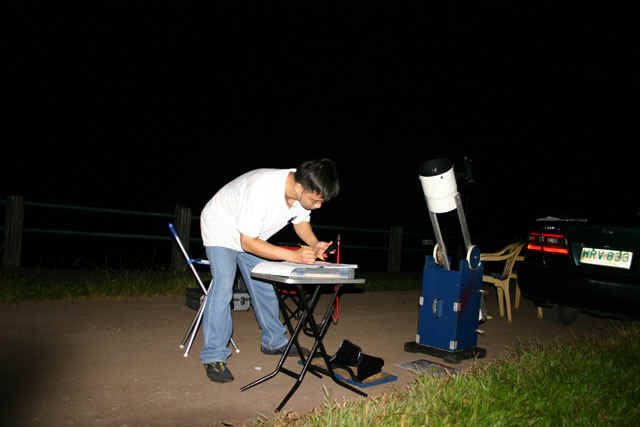 objects to find, but do skip a bit depending on my familiarity of
objects or proximity of some objects to the Dobsonian way. I note this since most sequence
guides published or given out by popular amateur astronomers are for the convenience of
those using equatorial mounted telescopes, that is it prioritized or focused on an area
given by a Right Ascension, then move through the Declination to ease finding and avoid
the burden of having to jump far from an object to another. I have yet to see a guide made
for the convenience of Dobsonian users, but this is practical, one universal guide could
not been made to suit all latitudes since earthly latitudes affects too much of the
inclination of the objects from the horizon. My Dobsonian mount is not perfect to aim at
the zenith because the butt or the bottom end of the tube will hit the ground board. I can
get away with this seemingly simple engineering problem since most Dobsonians are not
really "happy" to turn on its azimuth if the tube is aimed at the zenith. Why?
Torque is the concern, so even at the smoothest of all azimuth bearings, which I believe I
possess because of the Acrylic sheet and Virgin Teflon combination giving a very low
coefficient of friction, the zenith position cannot give the same amount of efficiency the
way a 45 degree altitude aiming can provide.
objects to find, but do skip a bit depending on my familiarity of
objects or proximity of some objects to the Dobsonian way. I note this since most sequence
guides published or given out by popular amateur astronomers are for the convenience of
those using equatorial mounted telescopes, that is it prioritized or focused on an area
given by a Right Ascension, then move through the Declination to ease finding and avoid
the burden of having to jump far from an object to another. I have yet to see a guide made
for the convenience of Dobsonian users, but this is practical, one universal guide could
not been made to suit all latitudes since earthly latitudes affects too much of the
inclination of the objects from the horizon. My Dobsonian mount is not perfect to aim at
the zenith because the butt or the bottom end of the tube will hit the ground board. I can
get away with this seemingly simple engineering problem since most Dobsonians are not
really "happy" to turn on its azimuth if the tube is aimed at the zenith. Why?
Torque is the concern, so even at the smoothest of all azimuth bearings, which I believe I
possess because of the Acrylic sheet and Virgin Teflon combination giving a very low
coefficient of friction, the zenith position cannot give the same amount of efficiency the
way a 45 degree altitude aiming can provide. 